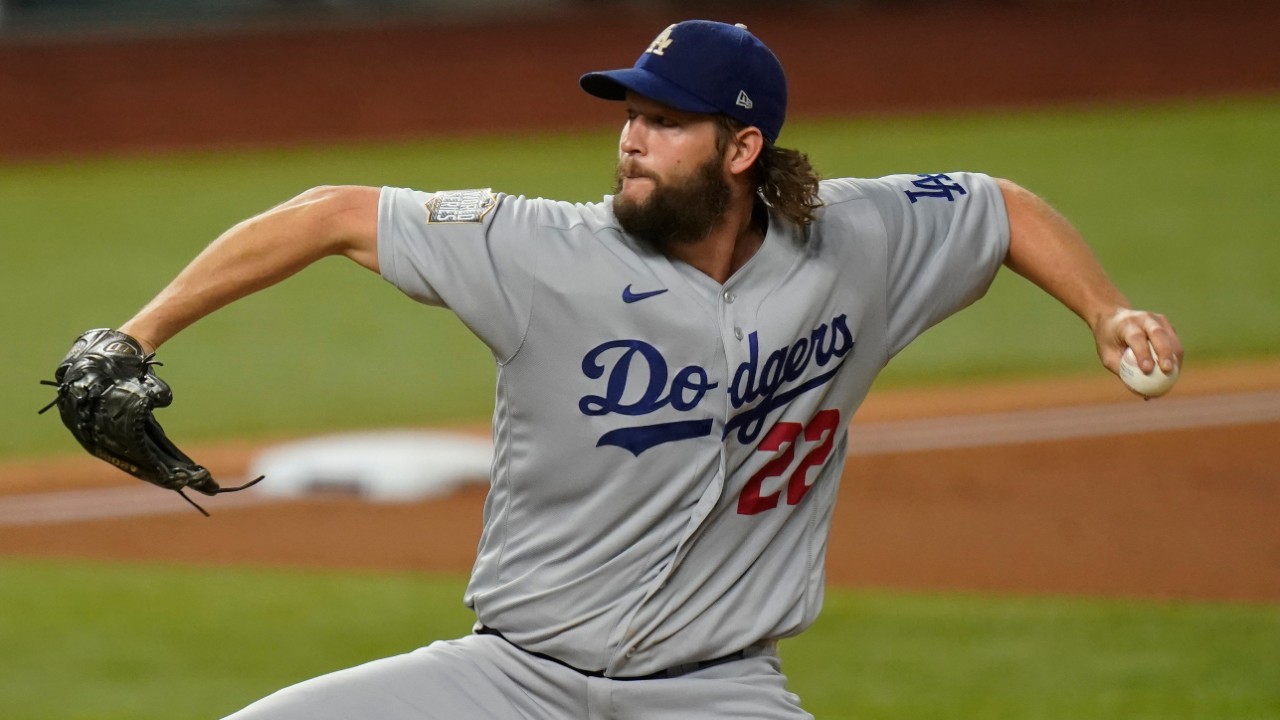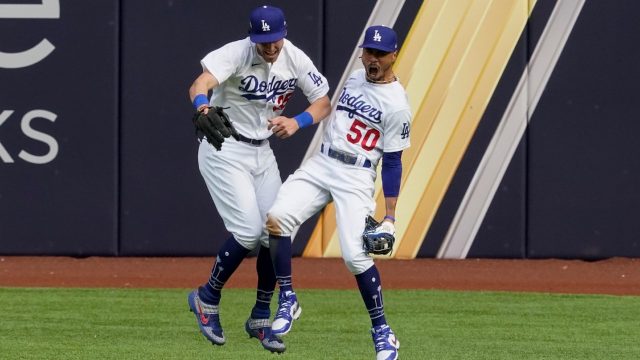
Less than 24 hours after one of the most insane finishes in World Series history, the Los Angeles Dodgers and Tampa Bay Rays were back at it in Arlington, Texas trying not to let Game 4’s hangover bleed into Sunday night’s critical Game 5.
And while it didn’t feature the drama and thrills of the night prior, Sunday’s contest was just as tense and nerve-wracking, as the Dodgers bullpen held on to a slim lead and won a nail-biter over the Rays, 4-2.
Now, everyone will take a much deserved breather on Monday before returning for Game 6 Tuesday night, in which the Dodgers will be playing to win their first championship since the Reagan administration, while the Rays will merely be playing to stay alive.
But before we get there, let’s look back at some takeaways from Game 5.
Your location could not be determined
There’s no denying Tyler Glasnow’s stuff. The Rays starter backs up an upper-90s fastball with one of the fastest-spinning curveballs in the game, which is how he struck out nearly 40 per cent of the batters he faced this season. The question is always location. Some nights, he’s landing those curveballs on either edge of the zone while locating fastballs to all quadrants, making him near unhittable. Some nights, he just doesn’t have that level of command, leading to spiked curveballs, fastballs too far out of the zoneand mistakes left right over the plate.
And as Glasnow worked early in Game 5, it became evident which of those nights it was going to be. He missed badly with three of his first four pitches to Mookie Betts, before ultimately leaving a fastball middle-middle that the Dodgers’ leadoff hitter was all too happy to rip into left field for a double:

Two pitches later, he hung a curveball in exactly the same location, which is the type of mistake really good hitters like Corey Seager do this to:
The @Dodgers came out swinging in this one as they take the early lead.
Watch Game 5 of the #WorldSeries on Sportsnet.#Postseason | #MLBonSN pic.twitter.com/FfibQDOvj2
— Sportsnet (@Sportsnet) October 26, 2020
Run scored. A couple wild pitches and a walk later, Cody Bellinger’s groundball single was enough to plate Seager from third:
That’s another way poor command can kill you. If Glasnow doesn’t bounce a couple pitches, allowing Seager to advance 90-feet each time, Bellinger’s groundball doesn’t cash a run. But Sunday it did in what became a 34-pitch first inning, the most Glasnow’s thrown in an opening frame all year.
Back out for the second, Glasnow was still missing — but this time he was doing it over the plate again. Two of his first three pitches to leadoff hitter Joc Pederson were grooved, and then there was this 1-2 fastball he probably wanted to land outside the zone:
Glasnow walked two more in the inning but got out of it thanks to a pair of loud foul balls that stayed in the yard. Still, he needed 51 pitches to get six outs.
Settling in for the third and fourth inning, as Glasnow did without much trouble, was huge for the Rays. After Saturday’s bullpen day, Tampa was not well equipped to cover a super short start. But while Glasnow was getting outs, his command still wasn’t where he needed it to be. And that caught up to him in the fifth when he threw Max Muncy this centre-cut, 3-2 fastball:
Ultimately, that was the story for Glasnow Sunday. He missed by too much both off the plate and on:

Some credit still has to go to the Dodgers. Their hitters executed the same approach they used against Glasnow in Game 1 of the series, when he walked six and was out of the game after throwing 112 pitches through 4.1 innings. Sunday, the Dodgers swung at only 44 of the 102 pitches Glasnow threw and barrelled eight of their 13 balls in play at 100 m.p.h. or more off the bat. The Dodgers waited Glasnow out, they didn’t chase and they punished mistakes.
If Glasnow’s locating, that approach can’t be as effective. If he’s landing curveballs on the edges of the zone and keeping his fastball at least close enough to the plate in order to generate swing-and-miss, he can be as dominant as he was at times during the regular season. But he couldn’t do that Sunday. And the question now becomes, if this series goes the distance, could he do it out of the bullpen in Game 7?
Not great, but good enough
We’ll spare you any further litigation of Clayton Kershaw’s post-season history and say simply that the Dodgers needed him in peak form Sunday night as they tried to rebound from a soul-crushing defeat a night earlier and claim control of what has become a three-game series.
They didn’t get peak form. But they got something close enough.
Kershaw breezed through his first two innings, but Kevin Kiermaier’s infield single on a two-strike slider well off the plate in the third brewed trouble. An out later, Kershaw left a fastball up to Yandy Diaz, who scored Kiermaier with a triple. And three pitches after that he hung a curveball to Randy Arozarena, who doesn’t miss those:
The Rays are on the board.
It’s a one-run game. pic.twitter.com/dOAWhG7HMM
— MLB (@MLB) October 26, 2020
A strikeout-caught-stealing double play got Kershaw out of it. But he walked Manuel Margot to lead off the fourth, and watched the Rays burner steal second and advance to third on an error. Another walk of Hunter Renfroe and suddenly Kershaw had runners on the corners and none out.
But he got two huge outs — one via pop up, one via strikeout — before Margot was nailed trying to steal home during Kershaw’s trademark extended wind-up to end the inning:
Manny Margot just tried to on Clayton Kershaw in Game 5 of the #WorldSeries #postseason | #MLBonSN pic.twitter.com/ovChk8DvCz
— Sportsnet (@Sportsnet) October 26, 2020
The straight steal of home was a risky play from a team that is nothing if not unafraid to take risks. Clearly the Rays felt they had Kershaw timed and that Margot was fast enough to sneak one past the goalie. Tampa was also challenging Kershaw to execute an unusual, tougher-than-it-looks play under immense pressure. He had to first step back off the rubber in order to not commit a balk before firing an accurate throw to the plate with an 89th percentile sprint speed runner sprinting in. That’s not automatic.
But that’s also what makes Kershaw’s composure even more impressive. His first instinct on an unexpected play occurring behind him was perfect. Watch his head. He never even sees Margot. He just reacts and lets muscle memory take over with an exceptionally well-executed play.
That’s the benefit of having a veteran like Kershaw on the mound. He doesn’t rattle. And while he didn’t give his team a peak outing Sunday, he gave them one that was good enough, completing 5.2 innings on 85 pitches before his manager gave him the hook.
Ironically, considering the debate over Kershaw’s post-season track record, Dodgers fans in attendance loudly booed the moment Kershaw was taken out of the game. He clearly had more in the tank. But it’s always better to lift a starter a few batters too early than a few batters too late — especially when you have relievers like the Dodgers do. And now Kershaw should be available to return out of the bullpen in a potential Game 7.
The bounce-back
To be fair, some of the consternation over Kershaw’s removal may have been in part due to the individual replacing him — Dustin May. The right-handed rookie’s had a rough ride of late, allowing runs in each of his previous three appearances, including three on four hits in Game 2 of this series.
The trouble had been May’s breaking pitches — a hard slider and curveball — which he wasn’t executing the way he needed to. Sliders were being left on the plate and getting teed off on. Curveballs were bouncing in the dirt uncompetitively.
But the good thing about being Dustin May is that you also have the option of simply throwing the ball 100 m.p.h. Which is what he did on Sunday, over and over again. Of the 30 pitches May threw over his 1.2 innings, 25 were fastballs. He threw just three curveballs and two sliders. Who needs spinning stuff when you’ve got 101 in your back pocket?
Dustin May, 101mphpic.twitter.com/PSH2Ufqd1d
— Rob Friedman (@PitchingNinja) October 26, 2020
That’s probably why Kiermaier was sitting all over a May fastball leading off the eighth, lining it to left for a single. But May got a quick out and then turned things over to Victor Gonzalez, who put another runner on but got two huge outs against Arozarena and Brandon Lowe to end the threat.
There was a real chess match playing out between Kevin Cash and Dave Roberts during that sequence, as the Rays manager pinch-hit multiple times to force May out of the game and gain platoon advantage over the left-hander Gonzalez. But Roberts ultimately trusted Gonzalez against the hottest hitter on the planet — Arozarena — in order to get to a plus matchup against Lowe. And it worked out.
Stick the landing
Evidently, Kenley Jansen wasn’t available in this one after pitching each of the last two days, as Roberts asked Blake Treinen to protect a two-run lead in the ninth. And that worked out just fine as Treinen rebounded from Margot’s leadoff single to retire the next three batters with ease. Locked in as ever, Treinen threw 10 of his 12 pitches in the save for strikes.
Sunday, the Dodgers needed big bullpen outs like that and they got them. And now, after Monday’s off day, Roberts should have his full complement of relievers to call upon in Game 6, including Jansen. Meanwhile, you know it’ll be all hands on deck for the Rays, as Cash must now manage every inning with extreme care.
This series has not been short on drama and suspense. It’s hard to imagine Tuesday’s Game 6 not delivering a good bit more.





